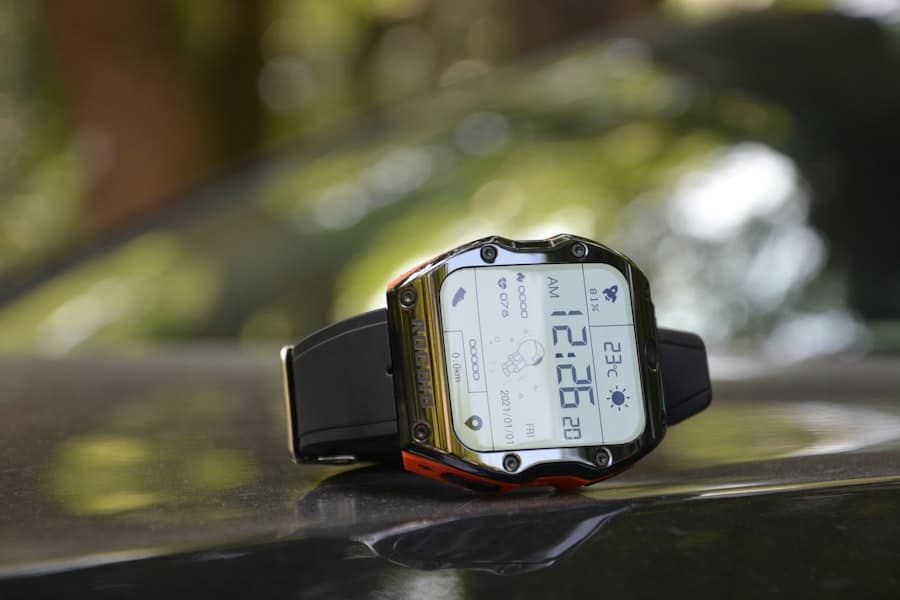In recent years, the intersection of technology and sustainability has garnered significant attention, particularly in the realm of wearable devices. Sustainable wearables are designed not only to enhance user experience but also to minimize environmental impact. These devices, which include smartwatches, fitness trackers, and health monitors, are increasingly being developed with eco-friendly materials and energy-efficient technologies.
The growing awareness of climate change and environmental degradation has prompted consumers to seek products that align with their values, leading to a surge in demand for wearables that prioritize sustainability. The concept of sustainable wearables extends beyond the materials used in their production; it encompasses the entire lifecycle of the product, from design and manufacturing to disposal and recycling. Companies are now focusing on creating devices that are not only functional but also environmentally responsible.
This shift is crucial as the electronics industry is one of the largest contributors to global e-waste, with millions of tons discarded each year. By integrating sustainable practices into the design and production of wearables, manufacturers can help mitigate the negative impacts of electronic waste while providing consumers with innovative solutions for health and wellness.
Key Takeaways
- Sustainable wearables play a crucial role in tracking environmental exposure and promoting personal and environmental health.
- Environmental exposure can have a significant impact on health, making it important to monitor and mitigate its effects.
- Wearables offer a convenient and effective way to track environmental exposure, providing valuable data for individuals and researchers.
- Sustainable wearables have the advantage of being eco-friendly and reducing the environmental impact of technology.
- While promising, sustainable wearables also face challenges and limitations that need to be addressed for widespread adoption and effectiveness.
Environmental Exposure and Its Impact on Health
Environmental exposure refers to the contact individuals have with various environmental factors, including air pollution, chemicals, noise, and radiation. These exposures can significantly affect human health, leading to a range of acute and chronic conditions. For instance, prolonged exposure to air pollutants such as particulate matter and nitrogen dioxide has been linked to respiratory diseases, cardiovascular issues, and even neurological disorders.
The World Health Organization (WHO) estimates that air pollution is responsible for approximately 7 million premature deaths annually, underscoring the urgent need for effective monitoring and intervention strategies. Moreover, environmental exposure is not limited to outdoor pollutants; indoor environments can also harbor harmful substances. Volatile organic compounds (VOCs) emitted from household products, mold growth, and inadequate ventilation can contribute to a host of health problems, including asthma and allergies.
Understanding the sources and levels of these exposures is critical for public health initiatives aimed at reducing their impact. As awareness of these issues grows, there is an increasing demand for tools that can help individuals monitor their environmental exposure in real-time.
The Role of Wearables in Tracking Environmental Exposure

Wearable technology has emerged as a powerful tool for tracking environmental exposure, providing users with valuable data about their surroundings. Devices equipped with sensors can measure various environmental parameters such as air quality, temperature, humidity, and UV radiation. For example, smartwatches and fitness trackers can be integrated with air quality sensors that detect levels of pollutants like ozone or particulate matter.
This real-time data allows users to make informed decisions about their activities, such as avoiding outdoor exercise during high pollution days or seeking cleaner environments. Additionally, wearables can facilitate personalized health insights by correlating environmental data with individual health metrics. For instance, a user experiencing respiratory issues can track their symptoms alongside air quality readings to identify potential triggers.
This integration of environmental monitoring with personal health data empowers users to take proactive measures in managing their well-being. Furthermore, the data collected by wearables can contribute to larger public health databases, enabling researchers and policymakers to better understand the relationship between environmental factors and health outcomes.
Advantages of Sustainable Wearables
Sustainable wearables offer numerous advantages that extend beyond their eco-friendly design. One significant benefit is their potential to promote healthier lifestyles by encouraging users to engage with their environment more mindfully. For instance, a sustainable wearable that tracks air quality can alert users when pollution levels rise, prompting them to adjust their outdoor activities accordingly.
This heightened awareness fosters a greater connection between individuals and their surroundings, ultimately leading to healthier choices. Moreover, sustainable wearables often incorporate energy-efficient technologies that reduce their carbon footprint. Many devices now utilize renewable energy sources or are designed for longevity, minimizing the need for frequent replacements.
This not only benefits the environment but also provides consumers with cost savings over time. Additionally, brands that prioritize sustainability often cultivate a loyal customer base that values ethical practices, enhancing their market position in an increasingly eco-conscious consumer landscape.
Challenges and Limitations of Sustainable Wearables
Despite the promising potential of sustainable wearables, several challenges and limitations persist in their development and adoption. One major hurdle is the cost associated with producing eco-friendly devices. Sustainable materials and advanced technologies often come at a premium price, which can deter consumers who are not yet fully committed to sustainability.
As a result, manufacturers must find ways to balance affordability with eco-conscious design without compromising quality or functionality. Another challenge lies in the accuracy and reliability of environmental sensors integrated into wearables. While advancements have been made in sensor technology, many devices still struggle with precision in measuring environmental factors.
Inaccurate readings can lead to misinformation and potentially harmful decisions by users who rely on this data for health management. Ensuring that sustainable wearables provide reliable information is crucial for building trust among consumers and maximizing their effectiveness in tracking environmental exposure.
Promising Technologies in Sustainable Wearables

The landscape of sustainable wearables is rapidly evolving, driven by innovations in technology that enhance both functionality and sustainability. One promising area is the development of biodegradable materials for wearable devices. Researchers are exploring alternatives to traditional plastics that can decompose naturally without harming the environment.
For instance, materials derived from plant-based sources or organic compounds are being tested for use in wearable casings and straps. Additionally, advancements in energy harvesting technologies are paving the way for self-sustaining wearables. Devices that can harness energy from body heat or movement reduce reliance on batteries and minimize electronic waste.
For example, piezoelectric materials can convert mechanical energy from user movements into electrical energy to power wearables. This innovation not only extends battery life but also aligns with the principles of sustainability by reducing the need for disposable batteries.
The Future of Sustainable Wearables in Environmental Exposure Tracking
Looking ahead, the future of sustainable wearables in tracking environmental exposure appears promising as technology continues to advance. The integration of artificial intelligence (AI) and machine learning algorithms into wearable devices could enhance their ability to analyze environmental data more effectively. By processing vast amounts of information from various sensors, AI could provide users with personalized recommendations based on their unique health profiles and environmental conditions.
Moreover, as public awareness of environmental issues grows, there is likely to be increased collaboration between tech companies, healthcare providers, and environmental organizations. Such partnerships could lead to the development of comprehensive platforms that combine wearable technology with community-level data on air quality and other environmental factors. This holistic approach would empower individuals not only to monitor their own exposure but also to contribute to broader public health initiatives aimed at improving community well-being.
The Importance of Sustainable Wearables for Personal and Environmental Health
Sustainable wearables represent a significant advancement in the quest for personal health management while addressing pressing environmental concerns. By providing users with real-time data on environmental exposure, these devices empower individuals to make informed decisions about their health and lifestyle choices. As technology continues to evolve and sustainable practices become more ingrained in product development, the potential for wearables to contribute positively to both personal well-being and environmental sustainability will only grow.
The importance of sustainable wearables extends beyond individual benefits; they play a crucial role in fostering a culture of awareness around environmental issues. By integrating sustainability into everyday technology, consumers are encouraged to consider their impact on the planet while prioritizing their health. As we move forward into an era where personal health is increasingly intertwined with environmental stewardship, sustainable wearables will undoubtedly be at the forefront of this transformative journey.
In a related article, Smartwatches Xiaomi Review, the latest advancements in wearable technology are explored, highlighting the features and capabilities of Xiaomi smartwatches.
As sustainability becomes a growing concern in the tech industry, it is important to consider how these wearables can be designed and manufactured with minimal environmental impact. By incorporating sustainable practices into the production of smartwatches and other wearables, companies can help reduce their carbon footprint and contribute to a healthier planet.
FAQs
What are sustainable wearables?
Sustainable wearables are electronic devices that can be worn on the body and are designed with environmentally friendly materials and manufacturing processes. These devices are often created with the goal of minimizing their impact on the environment throughout their entire lifecycle.
How do sustainable wearables track environmental exposure?
Sustainable wearables can track environmental exposure through various sensors and technologies embedded within the device. These sensors can measure factors such as air quality, UV exposure, temperature, and humidity, providing users with real-time data about their environmental surroundings.
What are the benefits of using sustainable wearables to track environmental exposure?
Using sustainable wearables to track environmental exposure can provide individuals with valuable insights into their personal environmental impact. This information can help users make more informed decisions about their daily activities, such as choosing less polluted routes for commuting or adjusting their outdoor activities based on UV exposure levels.
How do sustainable wearables contribute to environmental sustainability?
Sustainable wearables contribute to environmental sustainability by promoting the use of eco-friendly materials and manufacturing processes. Additionally, by providing users with data on their environmental exposure, these devices can raise awareness about environmental issues and encourage more sustainable behaviors.
Are there any challenges associated with sustainable wearables tracking environmental exposure?
Challenges associated with sustainable wearables tracking environmental exposure may include the accuracy and reliability of the data collected, as well as the potential privacy concerns related to the collection and use of personal environmental exposure information. Additionally, ensuring the sustainable disposal of these devices at the end of their lifecycle is also a consideration.

